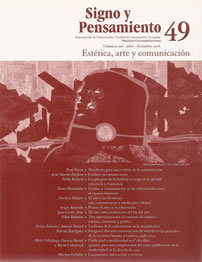Resumo
Muitos afirmam que o ideal de arte defendido pelo modernismo chegou ao fim. A história fundada pela arte moderna não se aplica mais a certas práticas contemporâneas, o que leva a crer que, para além da necessidade de uma nova história que dê conta da arte em suas diversas manifestações, deve-se reconhecer o fim das histórias, a impossibilidade de produzir. uma nova narrativa para substituir a modernista para incluir e legitimar as formas de arte hoje. É esse fim das narrativas que podemos entender, seguindo Arthur Danto, como o fim da arte, conceito que designa a transição da arte moderna para a arte contemporânea. O objetivo deste texto é compreender que lugar o cinema ocupa nesse trânsito —que, mais do que cronológico, é conceitual—, por meio da análise das noções de pureza e impureza na arte.
Agamben, G. (1993), “Teoría del gesto. Los medios puros”, en La modernidad como estética, Madrid, Instituto de Estética y Teoría de las Artes, p. 106.
Badiou, A. (2004), “El cine como experimentación filosófica”, en Yoel, G. (comp.), Pensar el cine 1. Imagen, ética y filosofía, Buenos Aires, Manantial, pp. 23-81.
— (2005), Imágenes y palabras. Escritos sobre cine y teatro, Rodríguez, M. C. (trad.), Buenos Aires, Manantial.
Bazin, A. (1994), ¿Qué es el cine?, López Muñoz, J. L. (trad.), Madrid, Rialp.
Danto, A. C. (1999), Después del fin del arte, Neerman, E. (trad.), Barcelona, Paidós.
— (2002), La transfiguración del lugar común. Una filosofía del arte, Mollá Román, A. (trad.), Barcelona, Paidós.
Deleuze, G. (1984), La imagen-movimiento, Agoff, I. (trad.), Barcelona, Paidós.
— (1985), La imagen-tiempo, Agoff, I. (trad.), Barcelona, Paidós.
Epstein, J. (1957), La esencia del cine, Buenos Aires, Galatea Nueva visión.
Greenberg, C. (1960), “Modernist Painting” [en línea], disponible en: http://www.sharecom.ca/greenberg, recuperado: 1 de octubre de 2006.
— (2002), Arte y cultura. Ensayos críticos, Beramendi, J. G. (trad.), Barcelona, Paidós.
Marzabal, I. (1998), Wim Wenders, Madrid, Cátedra. Rancière, J. (2000), Le partage du sensible. Esthétique et politique, Paris, Fabrique.
— (2004), “Lo inolvidable”, en Yoel, G. (comp.), Pensar el cine 1. Imagen, ética y filosofía, Buenos Aires, Manantial.
— (2005a), La fábula cinematográfica, Roche, C. (trad.), Barcelona, Paidós.
— (2005b, diciembre), “Las poéticas contradictorias del cine”, en Pensamiento de los Confines, núm. 17, 9-17.
Vertov, D. (1973), Cine-ojo. Textos y manifiestos, Llinás, F. (trad.), Madrid, Fundamentos.

Este trabalho está licenciado sob uma licença Creative Commons Attribution 4.0 International License.
Copyright (c) 2021 Juan Carlos Arias Herrera


